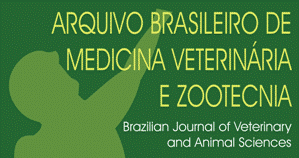Em central de transferência de embriões, após os procedimentos de reconhecimento do cio em 37 vacas receptoras, através de quatro rufiões vasectomizados, observou-se que 83% delas apresentavam retorno ao cio e algum corrimento serofibrinoso. Nos exames bacteriológicos realizados nos lavados prepuciais dos rufiões foi isolado o Campylobacter fetus subsp. venerealis em todos, fato que, analisado associadamente com o retorno ao cio das vacas receptoras, é indicativo da ocorrência de campilobacteriose no plantel. Essa ocorrência demonstra a necessidade de medidas eficazes de planejamento de saúde animal, pela utilização de rufiões com desvio lateral do pênis. Uma vez impossibilitado o contato sexual, seria impedida a transmissão do agente durante o coito. Torna-se imperioso consignar que a prática da prevenção racional de enfermidades continua sendo o procedimento mais econômico para uma produtividade animal mais rentável.
Bovino; rufião; Campylobacter fetus ssp. venerealis; Central de transferência de embriões

